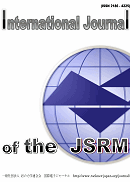Volume 19, Issue 1
Displaying 1-4 of 4 articles from this issue
- |<
- <
- 1
- >
- >|
-
2023Volume 19Issue 1 Pages 1-2
Published: 2023
Released on J-STAGE: December 28, 2023
Download PDF (447K) -
2023Volume 19Issue 1 Pages 3-4
Published: 2023
Released on J-STAGE: December 28, 2023
Download PDF (715K) -
2023Volume 19Issue 1 Pages 5-8
Published: 2023
Released on J-STAGE: December 28, 2023
Download PDF (697K) -
2023Volume 19Issue 1 Pages 9-12
Published: 2023
Released on J-STAGE: December 28, 2023
Download PDF (3062K)
- |<
- <
- 1
- >
- >|
